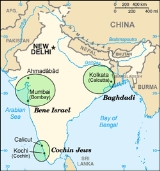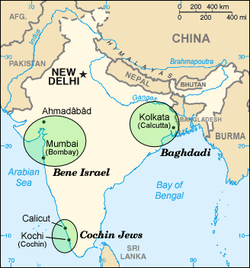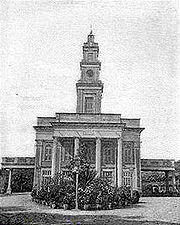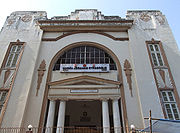
Synagogues in India
Encyclopedia

Bene Israel
The Bene Israel are a group of Jews who migrated in the 19th century from villages in the Konkan area to the nearby Indian cities, primarily Mumbai, but also to Pune, and Ahmedabad. Prior to these waves of emigrations and to this day, the Bene Israel formed the largest sector of the subcontinent's...
and Cochin communities
Cochin Jews
Cochin Jews, also called Malabar Jews , are the oldest group of Jews in India, with roots claimed to date to the time of King Solomon, though historically attested migration dates from the fall of Jerusalem in 70 CE. Historically, they lived in the Kingdom of Cochin in South India, now part of the...
as well as the more recent Baghdadi Jews
Baghdadi Jews
Baghdadi Jews, also known as Iraqi Jews, are Jewish emigrants from Baghdad and elsewhere in Iraq, who fled religious persecution and formed immigrant communities in their new homelands...
.
Origins

Mumbai
Mumbai , formerly known as Bombay in English, is the capital of the Indian state of Maharashtra. It is the most populous city in India, and the fourth most populous city in the world, with a total metropolitan area population of approximately 20.5 million...
, Kolkata
Kolkata
Kolkata , formerly known as Calcutta, is the capital of the Indian state of West Bengal. Located on the east bank of the Hooghly River, it was the commercial capital of East India...
, and Pune
Pune
Pune , is the eighth largest metropolis in India, the second largest in the state of Maharashtra after Mumbai, and the largest city in the Western Ghats. Once the centre of power of the Maratha Empire, it is situated 560 metres above sea level on the Deccan plateau at the confluence of the Mula ...
, are grand and built in various Western styles using fine materials and elaborate detail. Constructed by the Baghdadi Jewish community who first came from Iraq, Iran, and a handful of other Near Eastern countries and settled in India permanently beginning in the eighteenth century is a Neo-Baroque synagogue in the Fort section of Mumbai, a Renaissance revival one in central Kolkata
Kolkata
Kolkata , formerly known as Calcutta, is the capital of the Indian state of West Bengal. Located on the east bank of the Hooghly River, it was the commercial capital of East India...
and, in English tradition, a neo-Gothic structure in fine condition sitting within an open site in the Camp area of Pune.
Baghdadi synagogues
Baghdadi synagogues, some built with the support of the Sassoon familySassoon family
The Sassoon family was an Indian family of Iraqi Jewish descent and international renown, based in Bombay, India. It was descended from the famous Ibn Shoshans, one of the richest families of medieval Spain...
, all have particularly large Holy Arks where the Sefer Torah
Sefer Torah
A Sefer Torah of Torah” or “Torah scroll”) is a handwritten copy of the Torah or Pentateuch, the holiest book within Judaism. It must meet extremely strict standards of production. The Torah scroll is mainly used in the ritual of Torah reading during Jewish services...
s are stored. From the Ark's outside, the doors appear to cover a standard-sized cabinet typical to most synagogues around the world. Once the doors are opened in Indian Baghdadi synagogues, however, a sizeable walk-in room is revealed that is ample enough to store as many as one hundred Torahs.
Bene Israel synagogues

Ahmedabad
Ahmedabad also known as Karnavati is the largest city in Gujarat, India. It is the former capital of Gujarat and is also the judicial capital of Gujarat as the Gujarat High Court has its seat in Ahmedabad...
, and Pune in the very late eighteenth to early nineteenth centuries tend to be smaller. Since the Bene Israel Jews were by far the largest of the three groups of Indian Jews, they built the most synagogues. The first dates from 1796 in Mumbai, although this building, Shaar HaRahamim, was rebuilt in the mid-nineteenth century. The architecture of most Bene Israel synagogues is rarely stylistically pure and hence hard to define or label, although there are examples of buildings built in the 1930s by the Bene Israel communities of Mumbai and Ahmedabad that are pure Art Deco
Art Deco
Art deco , or deco, is an eclectic artistic and design style that began in Paris in the 1920s and flourished internationally throughout the 1930s, into the World War II era. The style influenced all areas of design, including architecture and interior design, industrial design, fashion and...
. A few, particularly those built by the Bene Israel Jews in the coastal Konkan
Konkan
The Konkan also called the Konkan Coast or Karavali is a rugged section of the western coastline of India from Raigad to Mangalore...
Region of Maharashtra
Maharashtra
Maharashtra is a state located in India. It is the second most populous after Uttar Pradesh and third largest state by area in India...
during the 19th century, are interesting blendings of colonial influences, vernacular building traditions, and Jewish liturgical requirements. At one time more than a dozen synagogues existed in these small coastal communities where communities of Jews lived, including at Pen, Alibag
Alibag
Alibag or Alibaug or Alibagh is a coastal town and a municipal council in Raigad District in the Konkan region of Maharashtra, India. It is also the headquarters of the Raigad district. The town and its surrounding villages are the historic hinterland of Bene Israeli Jews...
, Panvel
Panvel
Panvel is city and a municipal council in Raigad district in the state of Maharashtra. Panvel is also known as the gateway of Konkan region. It adjoins Navi Mumbai, and is just after the Thane district border. Panvel is located on the Yashwantrao Chavan Expressway about 21 kilometres from...
and Mhasala, but today many are closed or marginally operating due to the much dwindled Jewish population.
Cochin synagogues
Synagogues have rarely conformed to stylistic rules anywhere in the world or, as a building type, been resolved in unique or recognisable terms. Most of the buildings in India are no exception. In contrast are the synagogues built by the Cochin Jews of south-western India. Influenced by Indian building traditions coupled with the influences of visiting traders and imperialists over the centuries, the Cochin synagogues constitute wonderful examples of the vernacular thachusasthra design of Kerala. Until the 16th century and the arrival of the Portuguese in India, roofs of local buildings were often bamboo framed and covered with thatched palm leaves -- this technique still seen in Kerala's villages. The roof system would have been set on mud walls or atop simple masonry walls that were finished in smooth veneers. In time, this construction technique was replaced with wood framed roofs (often teak) covered with flat terracotta tiles together supported by thick laterite stone walls (a local material) veneered in chunam, a polished lime plaster. The local components were thus fused with foreign building techniques introduced by outsiders, namely the Portuguese and later the Dutch. These influences also impacted synagogue architecture and were combined with the Jewish ritual and liturgical requirements.Cochin synagogues are unique in the world in that they feature two bimah
Bimah
A bimah A bimah A bimah (among Ashkenazim, derived from Hebrew בּמה , almemar (from Arabic al-minbar) or tebah (among Sephardim) is the elevated area or platform in a Jewish synagogue which is intended to serve the place where the person reading aloud from the Torah stands during the Torah reading...
s. The primary one can be found within the sanctuary's main level where men have always sat. The second, used during holidays and special events, is found on the gallery level adjacent to the space dedicated for women's seating.
Found within all Indian synagogues is a central bimah (platform where the religious service is led), a Sephardic Jewish tradition. Other features of Indian synagogues are free-standing wooden benches, a profusion of hanging glass and metal oil lanterns, large shuttered windows with clerestories, a chair for the circumscion ceremony and one for the prophet Elijah, and separate seating areas for men and women.
Synagogues in the State of Maharashtra
The State of MaharashtraMaharashtra
Maharashtra is a state located in India. It is the second most populous after Uttar Pradesh and third largest state by area in India...
, which includes Mumbai
Mumbai
Mumbai , formerly known as Bombay in English, is the capital of the Indian state of Maharashtra. It is the most populous city in India, and the fourth most populous city in the world, with a total metropolitan area population of approximately 20.5 million...
(Bombay), its suburbs of Thana
Thane
Thane , is a city in Maharashtra, India, part of the Mumbai Metropolitan Region, northeastern suburb of Mumbai at the head of the Thane Creek. It is the administrative headquarters of Thane district. On 16 April 1853, G.I.P...
and Kurla
Kurla
Kurla is a suburb of Mumbai. It is also the name of one the busiest railway stations on the Mumbai suburban railway on the central and harbour railway lines of Mumbai...
, and the neighbouring Konkan region (a string of small towns and villages a day trip outside of the city) is where the largest number of synagogues were built. There are also two synagogues in Pune
Pune
Pune , is the eighth largest metropolis in India, the second largest in the state of Maharashtra after Mumbai, and the largest city in the Western Ghats. Once the centre of power of the Maratha Empire, it is situated 560 metres above sea level on the Deccan plateau at the confluence of the Mula ...
, one in New Delhi
New Delhi
New Delhi is the capital city of India. It serves as the centre of the Government of India and the Government of the National Capital Territory of Delhi. New Delhi is situated within the metropolis of Delhi. It is one of the nine districts of Delhi Union Territory. The total area of the city is...
, one in Ahmedabad
Ahmedabad
Ahmedabad also known as Karnavati is the largest city in Gujarat, India. It is the former capital of Gujarat and is also the judicial capital of Gujarat as the Gujarat High Court has its seat in Ahmedabad...
, and four in Kolkota (Calcutta). Not all of these structures are open today. Kerala
Kerala
or Keralam is an Indian state located on the Malabar coast of south-west India. It was created on 1 November 1956 by the States Reorganisation Act by combining various Malayalam speaking regions....
, in far south-western India, has six remaining buildings. Only one, in Kochi's (Cochin's) Jew Town, is a functioning house of prayer. It dates from 1568, although portions of the compound of parts were added later or altered over the years.
The synagogue in Chennamangalam
Following a seventeenth century plan devised by a local and tolerant leader in the town of Chennamangalam, four religious structures were built: a church, mosque, Hindu temple, and another Cochin synagogue. All still stand today, altogether rebuilt or much altered. By the turn of this century, this synagogue, which sat unused for many years with no Jews to use it, was in dire need of attention. In 2005, the Indian Department of Archaeology with funds mainly from the Department of Tourism restored the small white-washed structure. An international team made up of Professor Jay Waronker of the USA, Dr. Shalva Weil of Israel, and Ms. Marian Sofaer of the USA were responsible for the planning of a permanent exhibition in the spaces of the synagogues. These highlight the history and architecture of the Chennamangalam Jewish community and other Cochin Jews. The museum, which opened in February 2006, is open daily, except Sunday.The current Jewish population is likely less than 4,500. The number of Cochin Jews remaining in India is approximately 50, Baghdadi Jews number no more than a few hundred, and the balance are Bene Israel.
See also
- Paradesi SynagogueParadesi SynagogueThe Paradesi Synagogue is the oldest active synagogue in the Commonwealth of Nations, located in Kochi, Kerala, in South India. It was built in 1568 by the Malabar Yehudan people or Cochin Jewish community in the Kingdom of Cochin...
- Knesset EliyahooKnesset EliyahooThe Knesset Eliyahoo, also Knesset Eliyahu, is an 1885 synagogue in Fort in downtown Mumbai. It was built by Jacob Elias Sassoon and his brothers to commemorate their father and is run by the Jacob Sassoon Trust....
- Gate of Mercy SynagogueGate of Mercy SynagogueThe Gate of Mercy Synagogue , Hebrew: שער הרחמים) The Gate of Mercy Synagogue (Marathi: गेट ऑफ मर्सी सिनेगोग / जुनी मशिद), Hebrew: שער הרחמים) The Gate of Mercy Synagogue (Marathi: गेट ऑफ मर्सी सिनेगोग / जुनी मशिद), Hebrew: שער הרחמים) (also known as Shaar Harahamim and Juni Masjid is the oldest...
- Mumbai Chabad House
- Magen Abraham SynagogueMagen Abraham SynagogueThe Magen Abraham Synagogue was built in Ahmedabad in 1934 using donations from members of the Bene Israel Jewish community throughout the state of Gujarat. Magen Abraham is the only synagogue in the state and members travel from great distances for the High Holidays.The synagogue is built in the...
, AhmedabadAhmedabadAhmedabad also known as Karnavati is the largest city in Gujarat, India. It is the former capital of Gujarat and is also the judicial capital of Gujarat as the Gujarat High Court has its seat in Ahmedabad...

